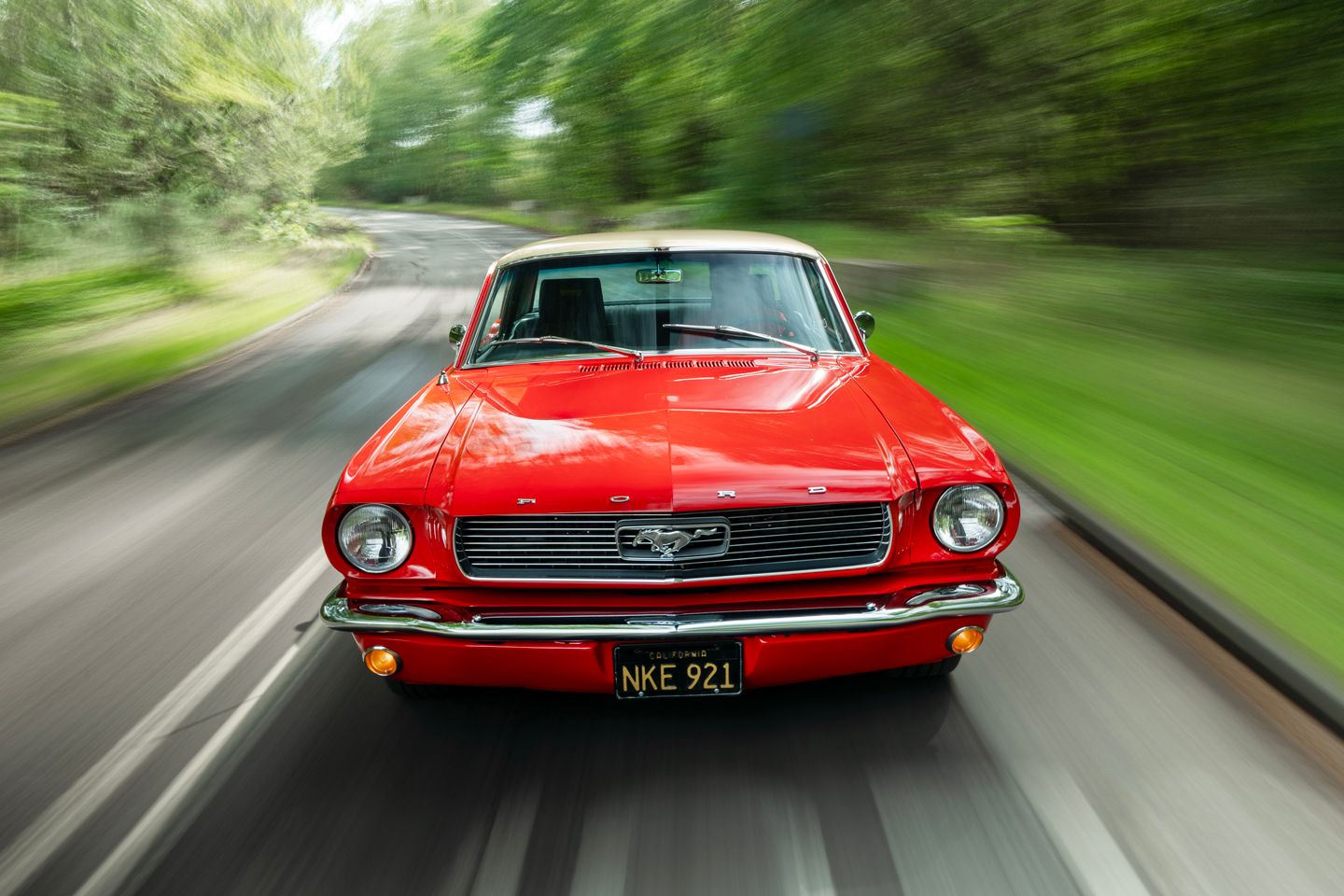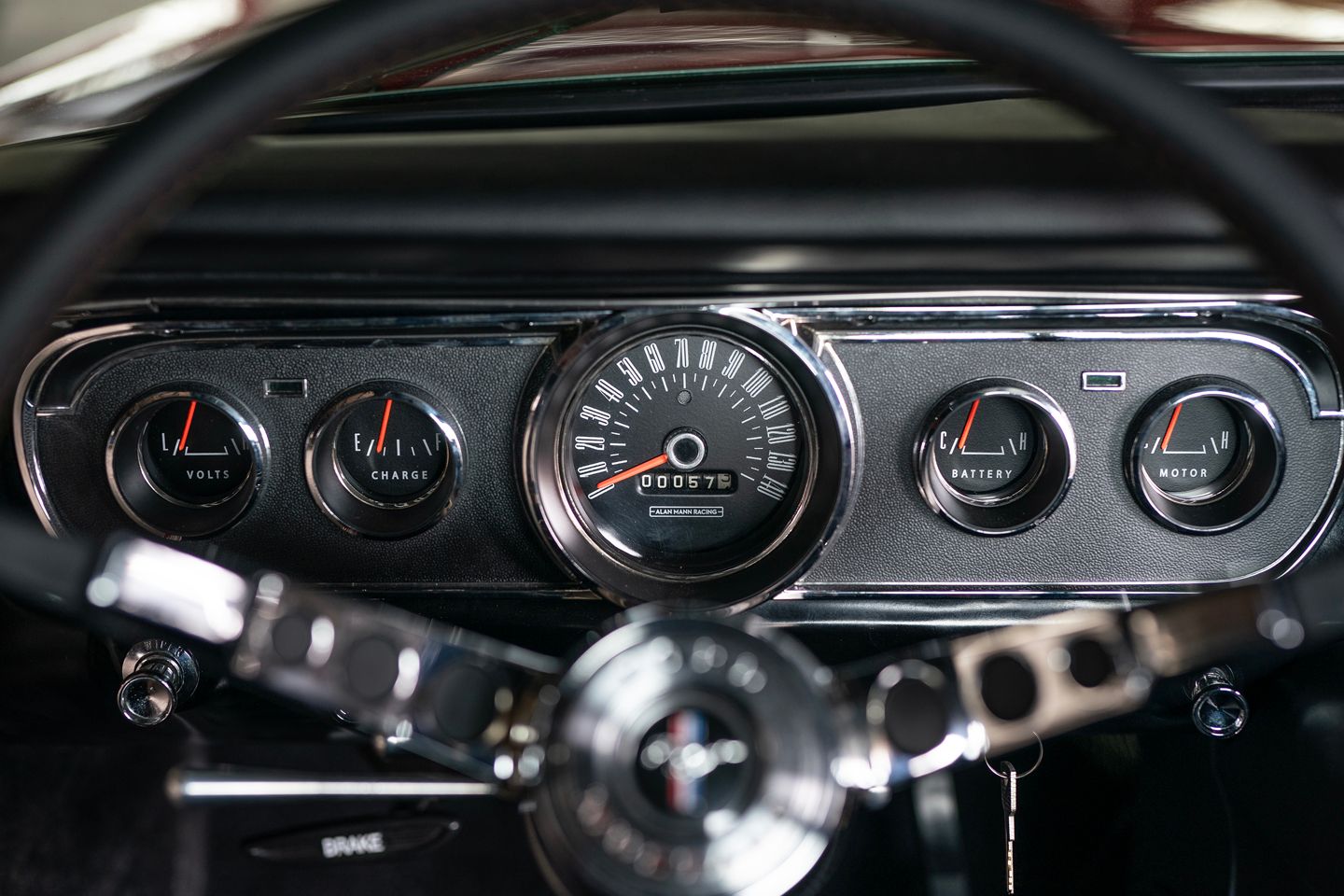Alan Mann Racing ePower Mustang | PH Review
[ad_1]

You’re right – the original Ford Mustang is not an obvious recipient for an electro-mod EV powertrain conversion. The first-generation ‘Stang is rightly famous for many things, but refinement and a lack of aural drama don’t make the list. To drive any version of the Ur-Mustang is to be bombarded with sensation, most of which comes from the old-school six-cylinder or V8 engines. Remove that and what have you got left?
This is the car that answers that question. The Alan Mann Racing ePower Mustang combines a famous name from ‘60s motorsport, the classic lines of a first-gen Mustang coupe and an engine-ectomy that has seen the original’s V8 replaced with a single electric motor. Also, what is effectively all-new suspension.
The last change being why silence is only part of the surprise. My previous experience of classic era muscle cars involved plenty of noise – always V8 in the case of the ones I’ve driven – but also buzzing vibration and what could be called a charmingly inexact driving experience. ‘60s Americana often feels like a loose alliance of different systems – vague steering, heaving suspension and brakes that, even as they left the factory, were marginal for something so fast. The ePower lacks all of that. Performance from the electric motor is smooth, instant and near silent, but it also steers with impressive precision, stops cleanly, corners hard and does so without the jacked-up roll angles and squealing noises that would come if trying to hustle a standard early Mustang.


Okay, the lack of noise does take some getting used to. The ePower uses a single electric motor, positioned where the gearbox would have originally sat and sending drive to the rear through a prop shaft and then a Torsen limited-slip differential. This produces a slight whine under hard use, but otherwise the cabin is almost freakishly silent. The uprated underpinnings, new interior and substantial amounts of noise insulation, mean the AMR Mustang doesn’t have any of the creaks and clonks you’d expect in any sixty-year-old car.
According to AMR’s Henry Mann, the prototype’s motor was making around 255hp when I drove it – although the production version is specced to have 300hp. Even with this lesser output, it felt respectably quick and not anachronistically faster than an original – for reference, the brawniest factory-built ’64 Mustang had a 271hp 4.7-litre V8. The ePower’s accelerator has soft initial responses to help with smoothness, but pushing harder delivers an immediate surge of torque – the peak of 229lb ft is well under the 312lb ft of the HiPo 4.7, but it feels impressively brawny. Off-the-line it’s doubtless quicker than any of its non-tuned combustion sisters; AMR quotes a 5.2-second 0-60mph using a launch control mode.
Not that the ePower would be winning any longer races with a V8 Mustang. The prototype was limited to just 85mph, the production version will be restricted to 97mph, and acceleration really tails off as it gets past 60mph. On the plus side, unlike the majority of electro-converted classics, the ePower was happy to deliver repeated bursts of full acceleration without any sense of the powertrain getting too hot and de-rating. The mild regenerative braking through the rear motor also worked seamlessly with the powerful retardation of the substantially upgraded all-disc brakes.


The ePower has two battery packs: one up front filling the erstwhile engine bay, with a smaller one at the rear where the fuel tank originally sat, connected by a high-voltage bus cable. The combined storage capacity is a claimed 72kWh – the charge port hidden behind the fold-down numberplate at the front – and the ability to support DC fast charging means it will be possible to take the battery from 20 per cent to 80 per cent in just 40 minutes. Which, in conjunction with a claimed 220-mile range, means the ePower will be viable for longer journeys as well as the A-to-A use common for less potent EVs. The powertrain has been engineered by established converter ECOClassics, and the expertise behind it is obvious.
Yet it’s the chassis changes which impress more. The chance to see the ePower raised on a ramp in AMR’s Surrey HQ revealed the scale of the transformation that has been made, the Mustang getting new subframes front and rear which mount double wishbone suspension at each corner with coil-over springs and dampers. There is a further bracing structure to link both subframes and further improve rigidity. The ePower also gets new rack-and-pinion in place of the original Mustang’s notoriously vague steering box.
The result is a car that drives in a much more modern way than its mostly unchanged design suggests it should. Despite the low ride height, the suspension copes impressively well with bumpy English backroads with no tyre-on-bodywork contact even taking dips and compressions at speed. The suspension is firm but purposeful, without float or wallow, and keeps the body under tight control at high speeds and under big loadings. Both of which it positively encourages thanks to the dialled-in steering and eager responses.


The prototype was running without the electric power steering the production version will receive – so had to be heaved into slower, tighter corners. The turning circle is also pretty dreadful thanks to the limited lock allowed by the new front subframe. But grip on Michelin Pilot Sport 4 tyres was both plentiful and finely balanced between the two axles, the LSD happy to police some smoky, low-speed hoonery.
Less convincing, for me at least, was the modified cabin. I like the way the original Mustang instruments have been repurposed so that the analogue dials now report on battery charge and voltage, as well as temperatures for the water-cooled motor and cell pack. But I wasn’t a fan of the revised centre console with its epoch-breaking touchscreen interface, even if the remodelling also brought some central air vents as well as a pair of cupholders. Given how standard the exterior looks – beyond the lowered suspension and right to wear a green-flash numberplate the demonstrator looks like a stock ’65 Hardtop – the cabin felt too flash and shouty for my tastes.
With the ‘what?’ covered off, let’s turn to the ‘why?’. Because the ePower’s Mustang’s origin story is both fascinating and deeply unlikely – effectively a joint project by two unrelated men called Henry Mann. One of these is the son of Alan Mann, the engineer-driver whose eponymous race team ran much of Ford’s European competition in the ‘60s. Alan died in 2012, with Henry taking over the family business of preparing cars for historic racing.


The other Henry Mann is a successful American entrepreneur and car collector from Philadelphia. He bought one of the Alan Mann Heritage editions of the modern Ford GT – the one finished in the same gold and red the team raced with – and thereby met the British Henry Mann when the new car was unveiled at the 2022 Chicago Auto Show. The pair got talking and soon discovered shared interests, including the appeal of an electrified 1970s Ford F-100 truck that was being shown on the same stand. Would it be possible to do something similar to a classic Mustang?
Just over 18 months later, the ePower demonstrator is the confirmation. Beneath the Alan Mann Racing branding and famous colour scheme the basic idea is for a proof of concept, one that shows it is possible to make a high-end conversion kit that can be applied to any Series 1 Mustang. The work has been funded by American Henry, who will be selling cars through a business called Mann ePower Cars in Pennsylvania, these aimed at those with substantial collections in search of something truly different. At the same time, Alan Mann Racing will look after interest on our side of the Atlantic, and is also promising that more AMR Legacy Edition cars will ultimately follow it.
Does the world need another six-figure electromod classic? The cost is anticipated to start at around £200,000 before taxes or the cost of a donor car… Feel free to fight that one out in the comments. But, before you do, American Henry does offer a justification beyond the easily debunked planet-saving ones often used for similar conversions.


“This is a classic that’s easy to drive, isn’t going to leak oil or require huge amounts of work on a regular basis,” he says. “It’s a ’64 Mustang you can drive every day – something you use where you wouldn’t take another classic.”
For what it’s worth, the ePower is the most convincing electro-mod I’ve experienced so far, much more so than the Everatti 911, Jaguar E-Type Zero concept or stillborn Aston Martin DB6 EV. But although electrification suits the classic Mustang surprisingly well, I remain convinced a big, dumb engine would suit it better.
SPECIFICATION | Alan Mann Racing ePower Mustang
Engine: Electric motor, rear-wheel drive
Transmission: Single-speed reduction, rear-wheel drive
Power: 300hp (production version)
Torque: 229lb-ft
0-60mph: 5.2sec
Top speed: 97mph (limited – production version)
Weight: 1476kg
MPG: TBC
CO2: 0g/km
Price: £200,000 (plus donor car, plus taxes)
[ad_2]